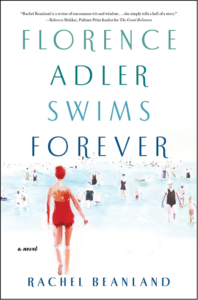 2020
2020
Fiction
$25.99; 306 pages
Simon & Schuster
ISBN: 978-1-9821-3246-0
Rachel Beanland’s Florence Adler Swims Forever
by Heather Routh
Rachel Beanland’s debut novel is based on a real-life family story, passed down through generations. It explores the lengths a mother will go to in order to protect one daughter while silently suffering the loss of another. In Atlantic City in 1934, Joseph and Esther Adler’s youngest daughter, Florence, drowns while training to swim the English Channel. Eldest daughter, Fannie, is on strict hospital bedrest due to a high-risk pregnancy. Fearing that the news could cause Fannie to lose the baby, after losing one the year before, Esther decides to keep the tragedy from her for the remainder of the pregnancy—the entire summer.
This becomes more problematic than Esther could have guessed. The news must be kept out of the paper, as well as their close-knit Jewish community, and the doctor and hospital staff are sworn to secrecy in order to minimize the risk of Fannie finding out from someone outside the family. This leaves the family without a support system to help them grieve. Soon they become deeply entwined in a web of complicated lies to cover Florence’s absence. Although this is done from a place of love, the effect isolates Fannie further. Everyone must guard what they say. It becomes easiest to avoid visits with her altogether, including the nurses on her ward, making only the necessary daily rounds but no longer staying to chat the way they once had. Her husband, Isaac, finds it a convenient excuse to visit only a few days a week and very briefly. Poor little 7-year-old daughter, Gussie, is kept away from her mother during a most confusing time.
I was most intrigued by the idea of writing a historical fiction piece where so much time had passed since the actual event, providing time to erode facts as well as open the possibility for exaggeration of elements due to repeated retelling. How does one find balance between preserving the family memory and building a compelling story? Beanland answers this by providing a thought-provoking tale filled with complicated and beautifully flawed characters. According to the author, a few characters are composites of real family members, while others never existed outside the author’s imagination. Yet they all come to life in the book, drawing the reader into tangled relationships and family drama.
Each chapter is told from a different character’s point of view, weaving in their story, their connection with Florence, and how they are coping with her death individually. We learn a lot about Florence through their eyes. It also provides a nice comparison between the characters, such as Stuart’s desire to prove his differences from his father—he is unwilling to use his family name as a leg up in life, preferring to work hard to achieve his own success. On the other hand, Isaac, who comes from humble beginnings, prefers to scheme and plot to get ahead, most often to the detriment of those closest to him. He is always looking for the next big thing that will provide the most reward with the least amount of effort. Although Esther is a devoted wife and mother, she is extremely judgmental, often unwilling to uncover the entire story before misjudging those around her. Many of her decisions seem selfish and rash. Meanwhile, her husband Joseph is much more level-headed and willing to help anyone that might need it. Sisters Fannie and Florence are separated by more than just age, but also by their life goals and dreams, each unable to see the value in the other’s choices.
Beanland has done a remarkable job recreating 1930s Atlantic City for readers—immersing us in wonderful detail of the lifeguard stations, the boardwalk with the bizarre Couney’s incubator exhibition, and the family-owned beach hotels—as well as the growing bureaucratic struggle American Jews undertook to help their European family and friends emigrate from Nazi Germany while they could. One can almost feel the hot, muggy coastal climate and cramped living conditions adding to the tension and frustrations the family is experiencing.
Florence Adler Swims Forever is a well-written, poignant historical fiction from a gifted storyteller exploring a family’s love and sacrifice in an uncertain time. It is well worth the read.
*
 Heather Routh is a Marketing and Advertising Copywriter and Social Media Strategist. She lives in the Rocky Mountains with her three sons and three dogs, and is obsessed with 70s rock albums, classic muscle cars, and murder mysteries. She is currently pursuing an MFA in Creative Writing from Sierra Nevada University.
Heather Routh is a Marketing and Advertising Copywriter and Social Media Strategist. She lives in the Rocky Mountains with her three sons and three dogs, and is obsessed with 70s rock albums, classic muscle cars, and murder mysteries. She is currently pursuing an MFA in Creative Writing from Sierra Nevada University.



